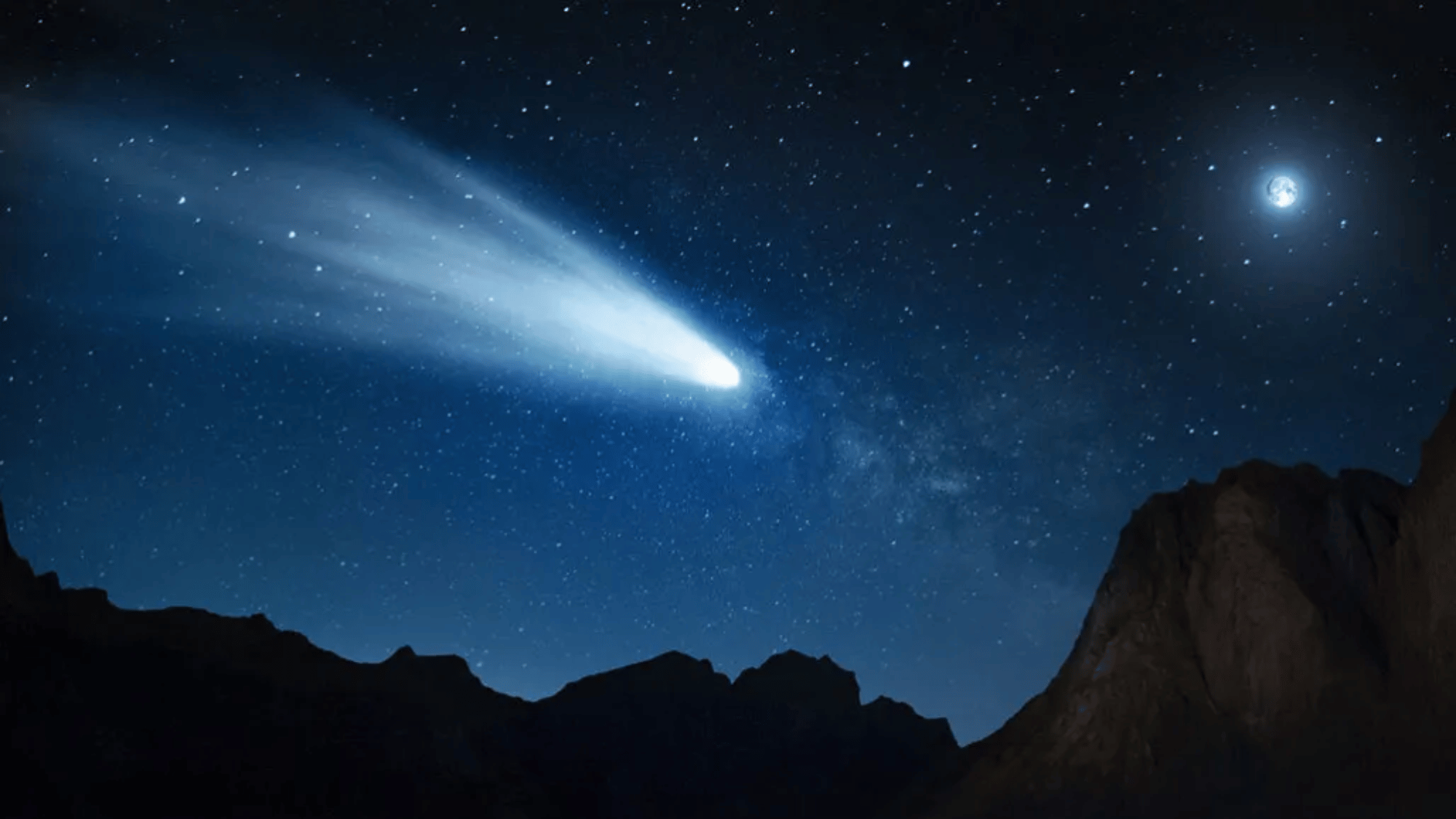For centuries, people have looked up at the night sky in awe, especially when a glowing comet streaks across it.
Comets have inspired myths, sparked curiosity, and even evoked a sense of fear in the past. But what exactly are these mysterious visitors from deep space?
Comets are icy bodies that travel around the Sun, leaving behind shining tails of light and dust.
This blog shares fun and fascinating facts about comets that make them more than just “dirty snowballs” drifting through space.
By the end, a person sees why these cosmic travelers remain some of the most captivating objects in our solar system.
What are Comets Made of?
Comets earn the fun nickname “dirty snowballs of space” because of their unique makeup.
Instead of being solid rocks, they’re icy mixtures made up of frozen water, dust, small rocks, and gases trapped since the beginning of our solar system.
Imagine holding one in your hand; it wouldn’t sparkle like a gemstone but would feel more like a chunky, frozen slushie with bits of gravel sprinkled through it.
This unusual blend is what makes comets so fascinating. When a comet approaches the Sun, its ice and gases heat up and begin to vaporize, releasing dust and glowing particles.
That’s when we see their famous, shining tails stretch across the night sky, turning these icy travelers into breathtaking cosmic shows.
Meet the Most Famous Comets
From Halley’s Comet to NEOWISE, some comets have captured worldwide attention. These famous visitors have left unforgettable marks on history, science, and even modern skywatching moments.
Halley’s Comet
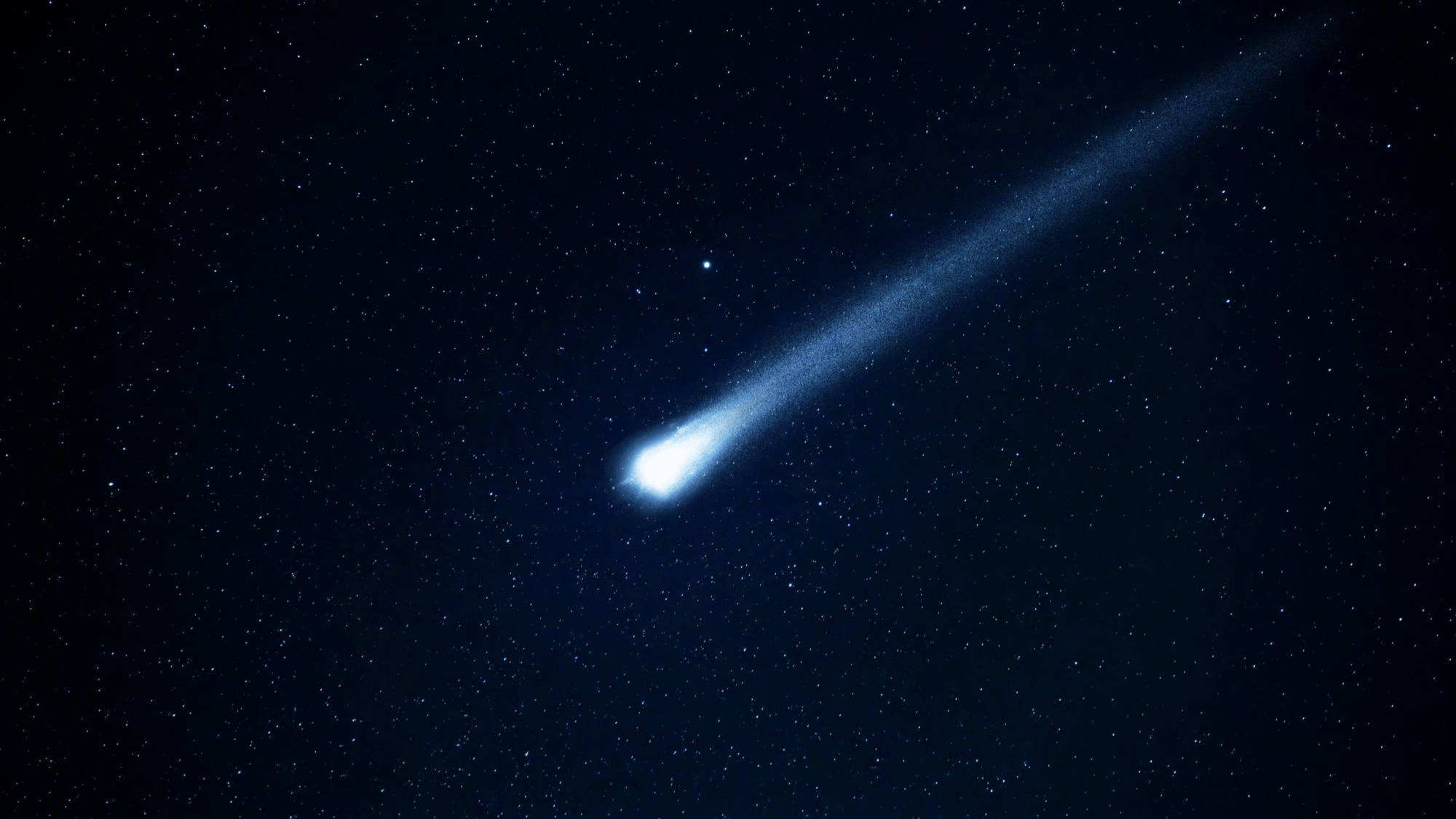

Image Source: WTOP
Halley’s Comet is the most famous of all, often called the “celebrity comet.” It orbits the Sun once every 76 years, making it visible to Earth watchers only once in a lifetime.
Last seen in 1986, Halley’s Comet has been recorded in history for thousands of years.
People all over the world eagerly await its next return, predicted for 2061, when it will once again light up the skies.
Comet Hale-Bopp
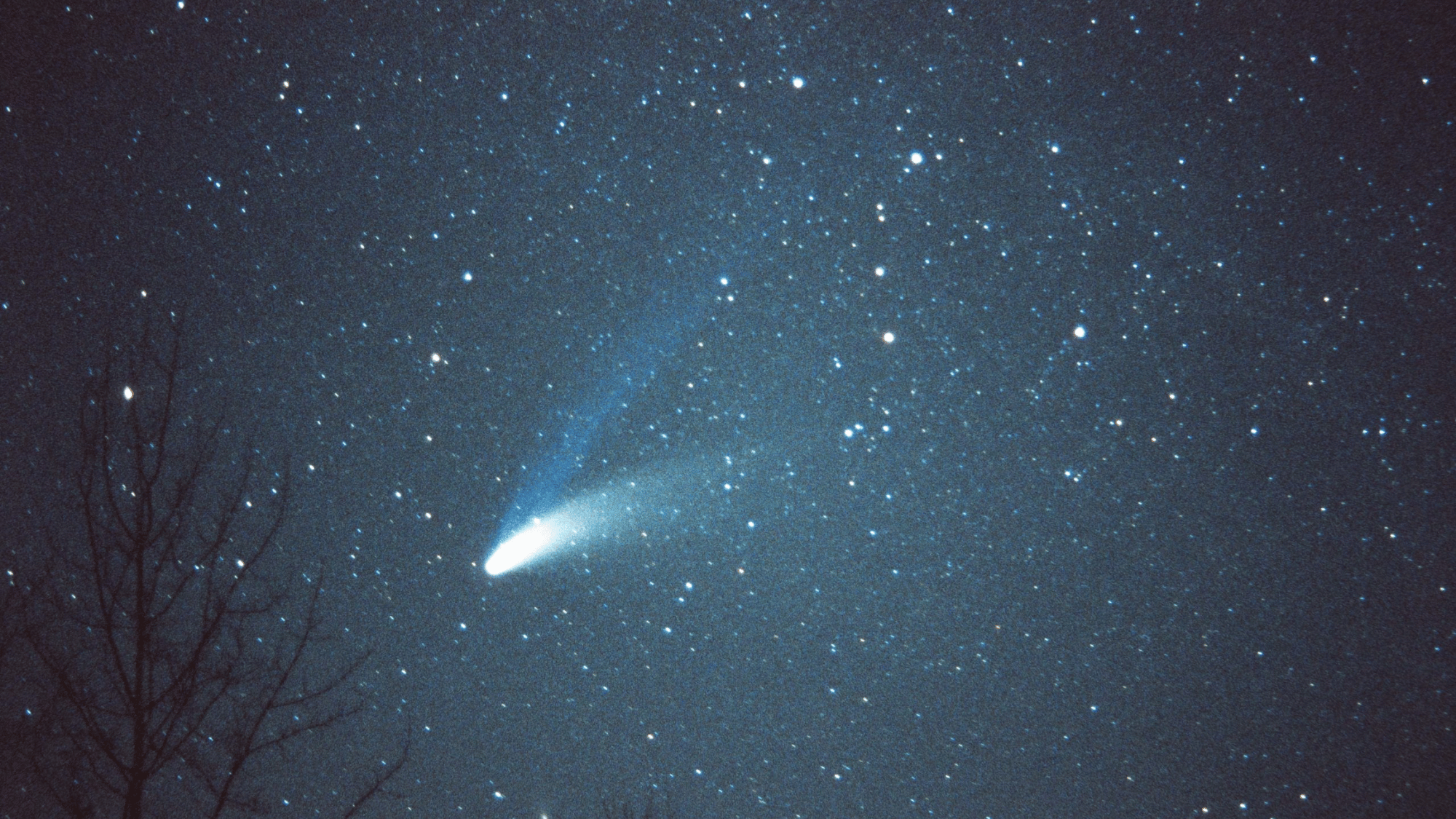

Image Source: CosmicPursuits
Comet Hale-Bopp, discovered in 1995, became one of the brightest comets of the 20th century.
It was so large and luminous that even people in brightly lit cities could spot it without the aid of telescopes. Visible for a record-breaking 18 months, it amazed millions worldwide.
Due to its extraordinary brightness and extended visibility, Hale-Bopp is often remembered as a once-in-a-lifetime spectacle in the history of modern skywatching.
Comet NEOWISE


Image Source: Newscientist
Comet NEOWISE made headlines in 2020, quickly becoming the “Instagram star of space.”
It was discovered by NASA’s NEOWISE mission and was easily visible to the naked eye, offering breathtaking photo opportunities.
Its twin tails and golden glow attracted millions of skywatchers who captured its beauty across social media.
NEOWISE brought a sense of wonder during a difficult year, reminding people everywhere of the vast beauty of our universe.
Comet Encke
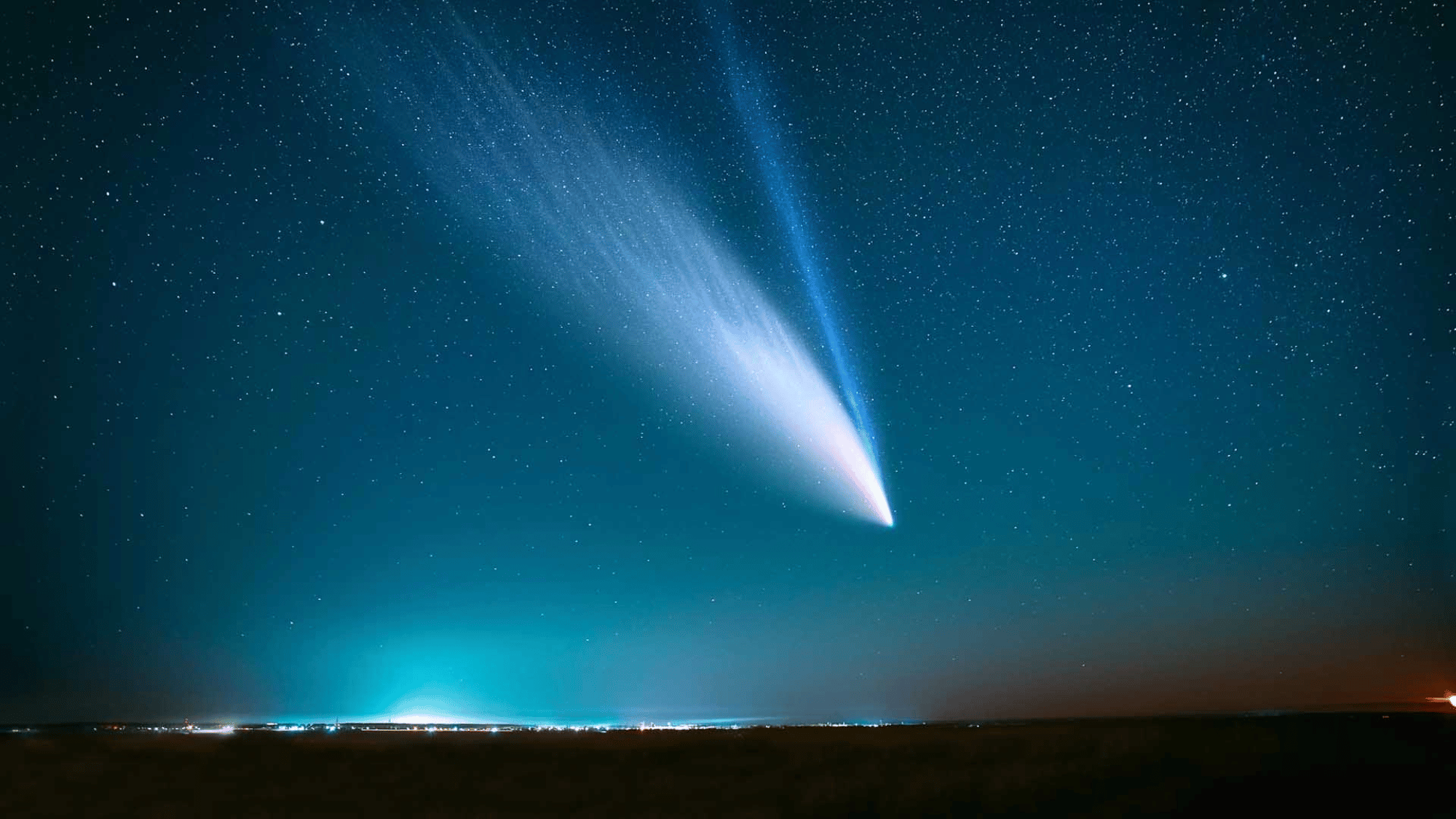

Image Source: Starwalk
Comet Encke is special because it has the shortest known orbit of any comet, just 3.3 years.
That means it regularly returns to our skies far more often than most comets. First recorded in the 18th century, Encke has been studied extensively by astronomers.
Though it’s not as bright as Halley’s or Hale-Bopp, its frequent visits make it a favorite for scientists tracking comet behavior and solar system history.
Comet Shoemaker-Levy 9
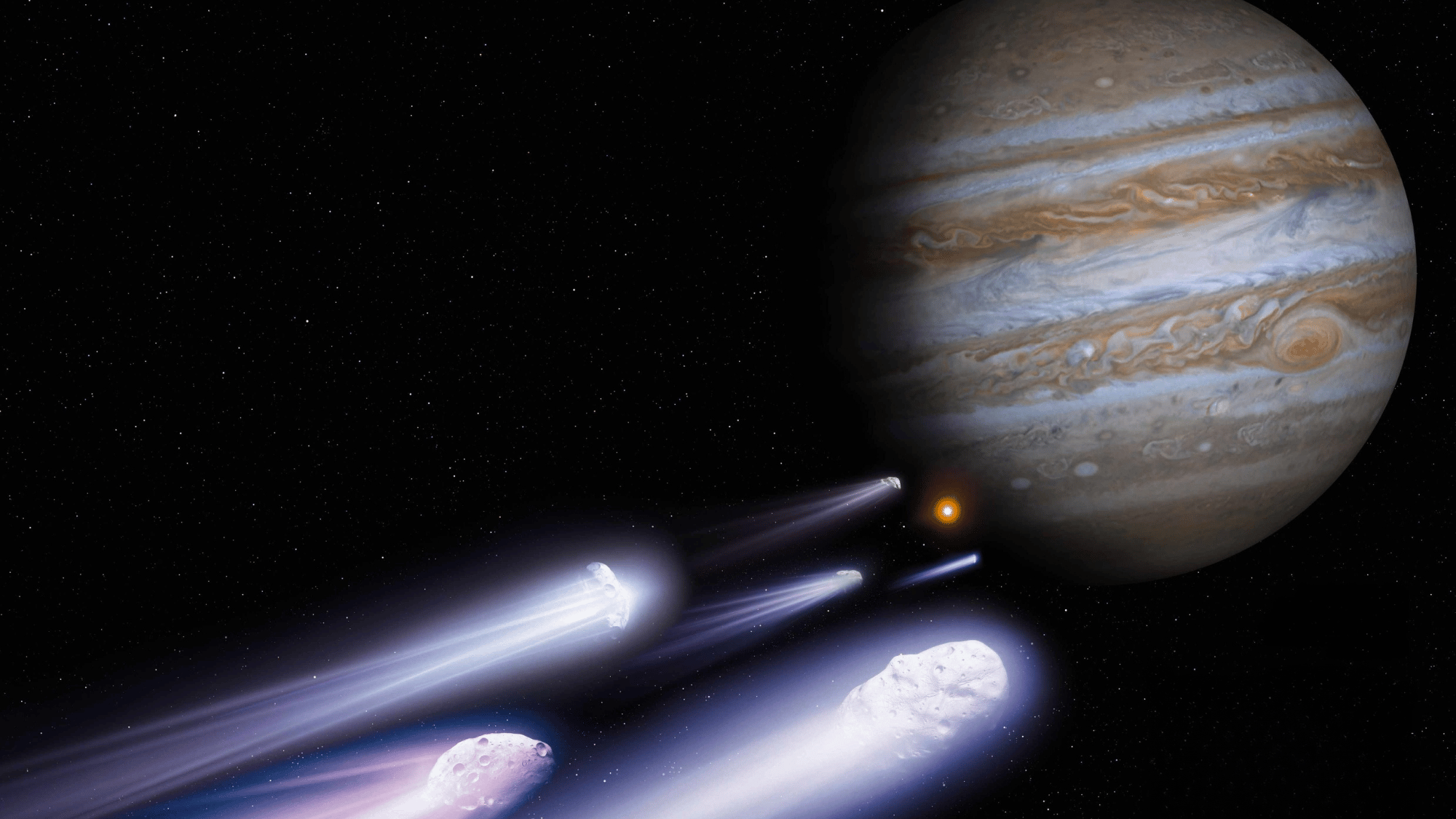

Image Source: Readly
Comet Shoemaker-Levy 9 gained fame in 1994 when it collided dramatically with Jupiter.
Instead of just passing by, it broke apart and slammed into the giant planet, creating enormous fireballs and scars larger than Earth.
This event gave scientists a rare chance to study both Jupiter’s atmosphere and the destructive power of comets.
Shoemaker-Levy 9 remains unforgettable because it showed comets aren’t just pretty; they can be powerful, too.
Interesting Facts About Comets
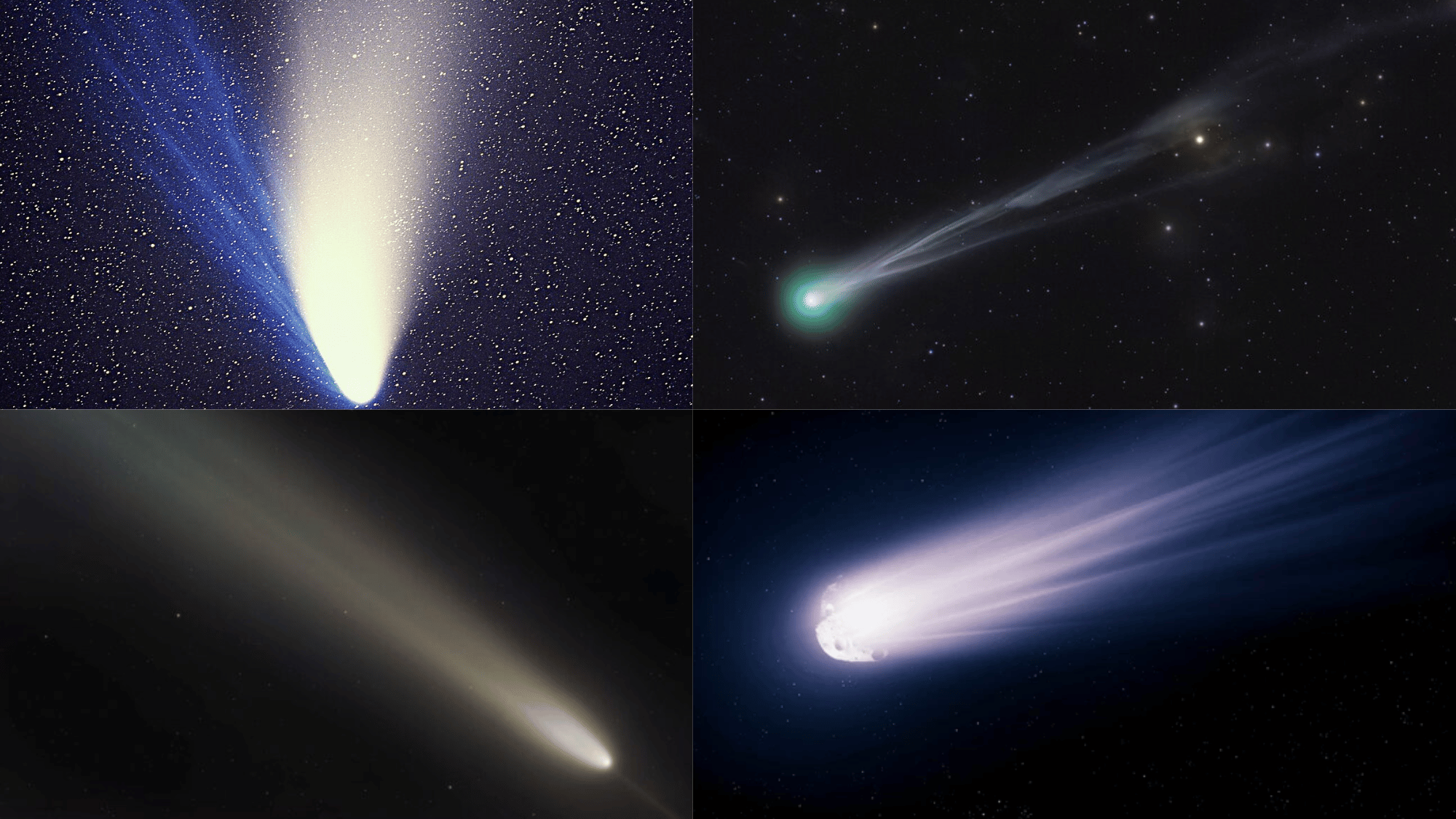

Comets are icy travelers from the outer solar system. These glowing wonders carry secrets of the past and inspire curiosity with their fascinating facts.
1. Comets are Ancient Leftovers
Comets are among the oldest objects in our solar system, formed over 4.6 billion years ago. They’re made from the original dust and ice that surrounded the young Sun.
Because they’ve remained mostly unchanged since then, scientists see them as frozen time capsules that preserve the early solar system’s ingredients.
Studying comets helps astronomers understand how planets formed and what materials existed long before Earth came to life.
2. Comets Come from Two Main Regions
Most comets come from either the Kuiper Belt, just beyond Neptune, or the faraway Oort Cloud, a vast icy shell surrounding the solar system.
The Kuiper Belt houses short-period comets, which return often, while the Oort Cloud sends long-period comets that may appear once in a lifetime.
These regions act like giant cosmic freezers, keeping comets preserved for billions of years until gravity pulls them toward the Sun.
3. Most Comets Live Beyond Neptune
For most of their existence, comets stay far beyond Neptune, where temperatures are unimaginably low. Sunlight is so faint that their ice and dust remain frozen solid.
Occasionally, the gravitational pull of nearby planets or passing stars disturbs their orbits, causing them to move inward toward the Sun.
That’s when we get to see their beautiful glowing tails, a rare appearance for something that spends centuries in darkness.
4. When a Comet Nears the Sun
As a comet travels closer to the Sun, heat causes its icy surface to vaporize. The gases and dust burst outward, forming a glowing cloud called a coma and a long, trailing tail.
This transformation makes comets look spectacular in the night sky.
The sunlight and solar wind push the material away, giving the comet its distinctive luminous streak, a breathtaking reminder of how energy shapes our solar system.
5. Every Comet Has Two Tails
Each comet actually has two distinct tails. The dust tail shines because it reflects sunlight, while the ion (gas) tail glows blue from charged particles reacting to solar wind.
These tails can stretch millions of kilometers into space, always pointing away from the Sun.
Sometimes both are visible at once, giving the comet a spectacular double-tail appearance that delights skywatchers and helps scientists study solar radiation and magnetic fields.
6. A Comet’s Tail Always Points Away from the Sun
No matter which direction a comet travels, its tail always points away from the Sun.
This happens because the solar wind, a stream of charged particles from the Sun, blows gases and dust outward.
So, the tail isn’t “trailing behind” the comet’s motion but rather being pushed by sunlight. It’s an amazing detail that showcases the Sun’s immense power and far-reaching influence.
7. The Word “Comet” Means “Long-Haired Star”
The word comet comes from the Greek word kometes, which means “long-haired star.” Ancient observers thought comets resembled stars with glowing hair or fiery tails.
Before telescopes, they couldn’t see that comets were icy bodies orbiting the Sun.
This poetic name has endured for centuries and still captures the beauty of these fleeting lights that appear suddenly, dazzle the night sky, and then vanish, leaving their mark on generations.
8. Halley’s Comet Will Return in 2061
Last seen in 1986, Halley’s Comet is due for another spectacular visit in 2061. Each time it swings past the Sun, scientists gather new data about its composition and orbit.
Over the centuries, it has inspired artists, scientists, and storytellers.
Its predictable return makes it one of the few cosmic events humans can anticipate across generations, a glowing reminder of both space’s beauty and its remarkable consistency.
9. Some Comets Appear Only Once
Not all comets return to the inner solar system. Some follow long, open-ended paths that fling them into deep space after just one appearance.
These are called non-periodic comets. They might never come back because their orbits take them so far away that the Sun’s gravity can’t pull them in again.
When we see them, it’s truly a once-in-a-lifetime cosmic event.
10. Comet Orbits Can Last for Ages
Comet orbits vary widely; some take a few years to circle the Sun, while others take millions.
Short-period comets come from the Kuiper Belt, looping back frequently, while long-period comets from the Oort Cloud journey across the solar system once in many human lifetimes.
These vast orbits remind us of the immense and dynamic nature of our solar system, with comets serving as time travelers through space.
11. Comet Encke Has the Shortest Orbit
Comet Encke stands out for its incredibly short orbit of just 3.3 years. That means it visits our skies more often than any other known comet.
Discovered in the 18th century, Encke has been closely studied by astronomers for over 200 years.
Although not readily visible to the naked eye, its frequent returns make it a favorite for scientific observation and a perfect example of a short-period comet.
12. Comets May Have Brought Water to Earth
Scientists believe that comets could have played a major role in shaping our planet’s oceans. Billions of years ago, countless comets collided with Earth, releasing frozen water and gases.
Over time, this water might have helped fill our oceans and atmosphere.
By studying comet samples, researchers compare their water composition with that of Earth’s, and the similarities are striking. This theory suggests comets were cosmic delivery trucks carrying life’s most essential ingredient: water.
13. Comets Might Have Carried Life’s Building Blocks
Beyond water, comets also contain organic molecules, the chemical ingredients needed to form life.
These include carbon, hydrogen, nitrogen, and oxygen compounds. When comets crashed into early Earth, they may have delivered these materials, jumpstarting biological development.
This fascinating idea makes comets not just icy rocks, but possible carriers of life itself. They could hold clues about how life began on our planet and perhaps on others as well.
14. Some Comets Break Apart Near the Sun
When comets venture too close to the Sun, intense heat and gravitational forces can tear them apart.
As their ice vaporizes rapidly, internal pressure builds until they fragment into smaller pieces. Sometimes, these fragments create temporary meteor showers or even disappear completely.
This process reveals how fragile, yet magnificent, comets are, short-lived cosmic wanderers that can meet dramatic ends after millions of years drifting through space.
15. The Rosetta Spacecraft Landed on a Comet
The European Space Agency’s Rosetta mission achieved a space first in 2014 by orbiting and landing on Comet 67P/Churyumov-Gerasimenko.
Its lander, named Philae, sent back close-up photos and valuable data about the comet’s surface. Scientists discovered complex organic molecules and unusual terrain features.
Rosetta’s groundbreaking work showed what comets are made of and how they behave up close, turning decades of telescope theories into real, hands-on science.
16. Comet 67P Has a Strange Smell
If humans could smell in space, Comet 67P would have quite the reputation.
Scientists detected gases such as ammonia, hydrogen sulfide, and formaldehyde around it, giving off an odor reminiscent of rotten eggs mixed with vinegar and bad perfume.
While not exactly pleasant, these chemicals reveal vital information about the composition of comets and the materials that shaped our early solar system.
17. Comets Don’t Glow on Their Own
Despite their brilliance, comets don’t actually produce light. Their glow comes from sunlight reflecting off their icy and dusty surfaces.
When they near the Sun, heat causes gases and dust to spread, forming a bright coma and tail that reflect sunlight beautifully.
This natural mirror effect creates the shimmering glow we see from Earth. In reality, comets are dark and cold objects that shine only through the light of other stars.
18. Comet Tails Can Stretch for Millions of Kilometers
A comet’s tail may look delicate, but it can stretch millions of kilometers across space, even longer than the distance between Earth and the Moon.
The tail’s immense length comes from dust and gas being pushed away by solar radiation.
Even with its size, the tail is extremely thin and diffuse, allowing a spaceship to pass through it with minimal resistance. It’s beauty on an epic, airy scale.
19. Comets are Surprisingly Lightweight
Though some comets span several kilometers across, they’re far lighter than one might expect. Their interiors are porous, full of empty spaces like a sponge.
This low density makes them fragile, explaining why they can break apart so easily near the Sun.
The fluffiness of comets also tells scientists how gently these cosmic snowballs formed in the early solar system, slowly clumping together rather than smashing into shape.
20. The Nucleus of a Comet is Quite Small
At the heart of every comet lies its nucleus, a solid core made of rock, dust, and ice.
The comet’s vast tail, the nucleus itself is usually just a few kilometers wide. It’s like comparing a grain of sand to a flying cloud.
The nucleus stores all the frozen material that vaporizes when the comet nears the Sun, fueling its glowing appearance and creating those spectacular celestial displays.
21. Ancient People Once Feared Comets
Before science explained their nature, ancient civilizations often saw comets as bad omens. Their sudden appearance and mysterious glow led many to believe they foretold wars, plagues, or the deaths of kings.
Records from Europe, China, and the Middle East describe comets as “fiery swords” or “harbingers of change.”
Over time, as astronomy evolved, comets became symbols of wonder rather than fear, reminders of humanity’s growing understanding of the cosmos.
22. Medieval Astronomers Called Them “Sky Messengers”
In medieval times, comets were sometimes referred to as “sky messengers” or “stars with tails.” People thought they carried messages from the heavens to humanity.
While these beliefs weren’t scientific, they show how deeply comets affected human imagination. Their rare visits made people reflect on destiny, fate, and the mysteries of creation.
Today, that same sense of awe remains, but now we interpret their “messages” through science and discovery.
23. Thousands of Comets Have Been Discovered
Astronomers have identified more than 3,000 comets, and new ones are found regularly thanks to advanced telescopes and space observatories.
Some are rediscoveries of known comets returning, while others are entirely new. These discoveries help scientists understand how comets move, change, and evolve.
As technology improves, we’re likely to uncover thousands more hiding in the dark edges of our solar system, waiting to be spotted.
24. NASA’s Stardust Mission Brought Back Comet Dust
In 2006, NASA’s Stardust mission became the first to collect and return dust from a comet. It traveled to Comet Wild 2, capturing tiny particles in special gel collectors.
When the samples arrived on Earth, scientists studied them to gain insight into the solar system’s origins.
The mission revealed minerals and organic compounds that were older than our planet, offering direct evidence of the ancient building blocks of life.
25. Some Comets Orbit Backward
While most objects in the solar system orbit the Sun in the same direction, some comets travel the opposite way.
These “retrograde” orbits likely result from gravitational interactions or collisions that flipped their paths.
This unusual movement makes them harder to predict and observe, but offers astronomers fascinating insights into how chaotic and dynamic our solar system can be.
26. In Deep Space, Comets are Invisible
When comets drift far from the Sun, they’re nearly impossible to detect. Without sunlight to illuminate them, they remain dark and cold, blending into space’s blackness.
Only powerful telescopes can spot these hidden wanderers in the distant Oort Cloud or Kuiper Belt.
Although invisible to the naked eye, these comets hold valuable clues about the frozen frontier of our solar system and the untouched materials that shaped it.
27. Some Comets Create Meteor Showers
When comets pass close to the Sun, they leave behind trails of dust and debris. As Earth moves through these trails each year, the particles burn up in our atmosphere, creating meteor showers.
The famous Perseid and Leonid showers originate from the remnants of ancient comets.
So every shooting star you see might be a tiny piece of a comet, a fiery reminder of its continuing influence on our skies.
28. Seeing a Comet is a Rare Treat
Spotting a comet with the naked eye is rare but unforgettable. Most appear only once in many lifetimes or shine faintly through telescopes.
When a bright one does visit, it becomes a worldwide event that unites skywatchers in awe.
Every comet we see is a traveler from the solar system’s edge, a glowing messenger from billions of years ago, reminding us of the vast beauty beyond Earth.
29. Comets Can Change Color
As comets approach the Sun, their appearance can shift from dull gray to glowing hues of white, yellow, or even blue.
These colors depend on the gases and dust released from the nucleus. For example, carbon monoxide and ionized gases can create a blue glow, while dust reflects golden sunlight.
This color transformation isn’t just beautiful; it also helps astronomers determine the elements present in the comet’s icy core.
30. Comets Can Split Into Multiple Pieces
Sometimes comets don’t survive their close passes near the Sun. The extreme heat and gravitational forces can tear them apart, creating smaller fragments that continue orbiting independently.
This process, known as fragmentation, can produce temporary mini-comets or beautiful meteor showers on Earth when the debris enters our atmosphere.
Astronomers have even watched comets like Linear and Swan break apart, giving rare insight into their fragile, icy structure.
31. Comets Have Helped Date the Solar System
Scientists study comets because their ices and dust have remained largely unchanged for billions of years.
By analyzing comet samples and comparing isotopes, researchers estimate when the solar system began forming. Comets act like natural archives, preserving frozen records of conditions that existed 4.6 billion years ago.
Their composition offers time-stamped clues about the earliest moments of planetary creation, helping scientists piece together how the Sun and planets evolved.
32. Comets Can Be Older Than the Sun
The gases and dust trapped within them likely came from ancient interstellar clouds that existed before the Sun ignited.
When the solar system formed, these primordial ingredients became locked inside comets.
Studying their isotopes and chemical fingerprints allows scientists to trace matter that existed before our Sun’s birth, making comets literal pieces of pre-solar history.
Conclusion
Comets are some of the most fascinating travelers in our solar system. From their icy, rocky cores to their glowing tails, they continue to capture human curiosity and spark wonder.
By learning facts about comets, we find out not only how they shine across our skies but also how they hold clues to Earth’s earliest history.
Some may have even delivered water and essential ingredients for life to our planet. Either famous comets like Halley’s or modern visitors like NEOWISE, each one tells part of the universe’s story.
Next time someone sees a comet streak by, they’ll understand just how extraordinary these cosmic messengers truly are.



